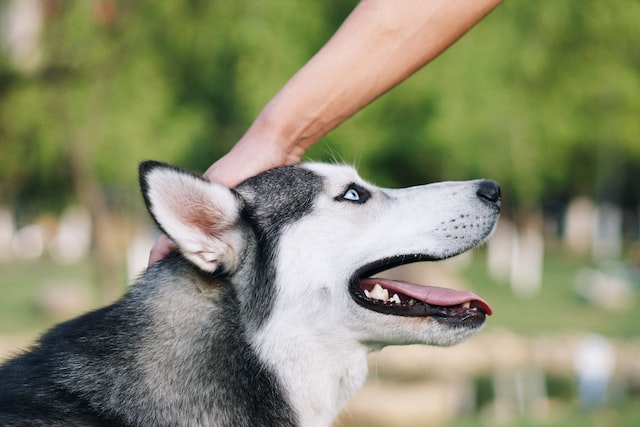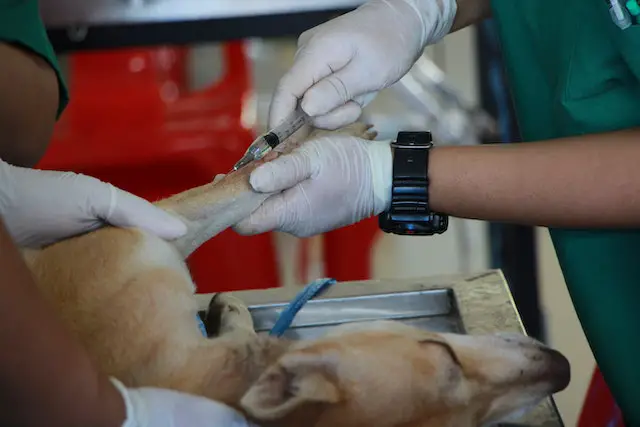When it comes to canine health, thyroid illness is surprisingly common. Discovering that your pup suffers from thyroid disease, even if it can typically be treated, is naturally alarming for any pet owner. As we go along, we will discover this type of illness in canines and how it affects the lives of our furry companions.
What is Thyroid Gland?
One of the most significant glands in the body is the thyroid gland. Its location in the neck is close to the trachea, often known as the windpipe. It divides into a left and right lobe on either edge of the trachea. The pituitary gland, found at the brain’s base, is responsible for controlling the thyroid gland.
What Does the Thyroid Gland Do?
 An endocrine gland, the thyroid gland generates thyroid hormones that control various bodily metabolic processes. Cells engage in metabolic processes, releasing energy from nutrients or converting energy into other molecules. Numerous different organs in the body require thyroid hormones to function at normal, healthy levels.
An endocrine gland, the thyroid gland generates thyroid hormones that control various bodily metabolic processes. Cells engage in metabolic processes, releasing energy from nutrients or converting energy into other molecules. Numerous different organs in the body require thyroid hormones to function at normal, healthy levels.
There is an enhanced body’s metabolism if an overactivity of the thyroid gland occurs. Meanwhile, the metabolism slows if the thyroid gland is underactive. The process of the body that burns food is also the function of the thyroid gland.
Types of Thyroid Disorders In Dogs
To help you figure out what’s wrong with your dog, below is a detailed explanation of the most common thyroid problems that dogs can have.
Hypothyroidism in Dogs
Dogs with hypothyroidism are more likely to gain weight for no apparent reason, may experience skin and hair problems, act strangely, and have less energy.
What Is Hypothyroidism In Dogs?
In the event of canine hypothyroidism, the gland produces too little of the hormone. It affects a lot of dogs. Moreover, all dog breeds may suffer from this thyroid problem, the most affected species is the Golden Retriever. And those medium-to-large dogs under the age of 4 and 10 predominantly suffer a lot.
 Some hypothyroidism episodes are due to immune system attacks on the dog’s thyroid. Other factors include the thyroid’s shrinkage and, albeit infrequently, a thyroid tumor. There is no difference in symptoms or treatments, regardless of the underlying cause.
Some hypothyroidism episodes are due to immune system attacks on the dog’s thyroid. Other factors include the thyroid’s shrinkage and, albeit infrequently, a thyroid tumor. There is no difference in symptoms or treatments, regardless of the underlying cause.
Causes of Hypothyroidism in Dogs
The source of hypothyroidism in dogs generally comes through outside influences. Typical dog food or raw food diet, dog immunization, and choke collars are some of them. Others may include environmental pollutants, chemicals in chew toys like phthalates, PCBs, and antibacterial ingredients in dog soap.
Signs of Hypothyroidism in Dogs
Hair loss is one of the symptoms of hypothyroidism and typically affects your dog’s tail, backs of the hind legs, and trunk. They will have thin, dull fur and red, flaky skin but are not itchy (usually related to fleas or an allergic reaction). They could have dark skin lesions.
Following this are symptoms like weight gain, contrary to having less appetite. Also noticeable are sluggishness, muscle loss, ear infection, toenail, a slowed heart rate, and cold intolerance. Hypothyroidism is rare, but it can cause seizures, heart and blood vessel problems, and the inability to bear offspring.
Diagnosis of Hypothyroidism in Dogs
If there is a misdiagnosed dog’s condition, hypothyroidism highly fits in. The similarity of hypothyroidism to other illnesses is the main reason for this. Because of that, thyroid medicine has been shown to alleviate symptoms or improve some illnesses.
The diagnosis of hypothyroidism in dogs will depend on the clinical symptoms and thorough diagnostic procedures determined by the veterinarian. This will usually require several blood tests to see if your dog has signs that often connect to the disease and ongoing monitoring of the thyroid level.
Your dog’s T4 levels will most likely be tested during one of these procedures. Even though this is a good first test for hypothyroidism, your vet might suggest doing more tests to get a precise result.
Treatment of Hypothyroidism in Dogs
 The dog’s thyroid hormone levels must be raised or replenished to treat this condition. One way to evaluate the efficacy of a treatment is by observing the rate at which symptoms diminish. There should be no noticeable difference in the coat or weight for at least 4–8 weeks after starting treatment.
The dog’s thyroid hormone levels must be raised or replenished to treat this condition. One way to evaluate the efficacy of a treatment is by observing the rate at which symptoms diminish. There should be no noticeable difference in the coat or weight for at least 4–8 weeks after starting treatment.
Also, monitoring serum thyroid hormone levels helps determine if a patient’s thyroid hormone dosage has to be changed. After settling on a maintenance dose, the schedule of monitoring the thyroid hormone levels is annually or semiannually. As a rule, treatment is ongoing for the rest of the dog’s life. Another problem may be your dog’s health deterioration while on thyroid medication.
Hyperthyroidism in Dogs
While canine hyperthyroidism is uncommon, it can cause significant issues for your dog if he or she contracts it.
What is Hyperthyroidism in Dogs?
In hyperthyroidism, an endocrine disorder that causes the thyroid glands to overproduce thyroid hormones, the body’s metabolism is constantly in overdrive. Thyroid glands are constantly producing hormones.
Causes of Hyperthyroidism in Dogs
When the thyroid gland in your pet generates an excessive amount of hormones, a condition known as hyperthyroidism develops. Hyperthyroidism is a life-threatening disorder that affects dogs, but it is uncommon. Thyroid carcinoma is the most prevalent cause of hyperthyroidism, a type of thyroid cancer that is fast-growing and highly aggressive.
Signs of Hyperthyroidism in Dogs
 Hyperthyroidism in dogs may be seen through the manifestation of its signs and symptoms. If your dog has hyperthyroidism, it may most likely lose weight even if changes in its appetite are not happening. They are always thirsty and always on the go to consume an excessive amount of water. Dog hyperthyroidism may also be detected through increased heart rate, cardiac murmur, diarrhea, vomiting, increase in the production of stool, and shortness of breath.
Hyperthyroidism in dogs may be seen through the manifestation of its signs and symptoms. If your dog has hyperthyroidism, it may most likely lose weight even if changes in its appetite are not happening. They are always thirsty and always on the go to consume an excessive amount of water. Dog hyperthyroidism may also be detected through increased heart rate, cardiac murmur, diarrhea, vomiting, increase in the production of stool, and shortness of breath.
Diagnosis of Hyperthyroidism in Dogs
An elevated heart rate or the presence of a tumor on your dog’s thyroid can be detected during a routine exam. If the veterinarian suspects hyperthyroidism, he may order blood testing to measure thyroid hormone levels and provide a definitive diagnosis.
Treatment of Hyperthyroidism in Dogs
Canine hyperthyroidism and thyroid cancer therapy trajectories are highly condition-specific, changing following tumor characteristics such as size and stage of progression. Radium iodine, surgical thyroid removal, and radiation therapy are all potential treatments. Medication for hyperthyroidism may help with symptoms, but it won’t cure cancer that’s likely the underlying cause. Although there is a close association between thyroid cancer and hyperthyroidism, the prognosis is dismal.
Autoimmune Thyroiditis
Dogs of specific breeds are more likely to develop canine autoimmune thyroiditis, a thyroid disease. Akita, Beagle, Doberman Pinscher, and Golden Retriever dogs are particularly susceptible to this. It develops when the body’s immune system mistakenly targets the thyroid.
Hypothyroidism may be the only symptom of autoimmune thyroiditis, but the condition can also be a warning indication of something more serious, including pan endocrinopathy or systemic lupus erythematosus. This is one of the many reasons why a correct diagnosis of hypothyroidism is so essential.
Goiter in Dogs
Goiters occur in dogs when the thyroid is underactive or when the pituitary gland fails to provide the thyroid with the right signals. Goiters can develop at any time, in any species, under any circumstances.
This kind of thyroid problem form in canines once the thyroid gland expands and grows in size. A veterinarian can use this non-life-threatening symptom to diagnose and treat a more serious underlying issue.
How to Determine the Proper Dose of Treatment
All dogs initially received thyroid replacement hormone at a fixed, body-weight-based dosage. The thyroid hormone levels are monitored through a blood test after the first month of medication. Due to the fluctuating nature of hormone levels, blood sample collection happens immediately before or after a dose of medicine.
Due to fluctuations in the dog’s tolerance for the synthetic thyroid hormone, the dosage may require to be adjusted frequently.
Changes in the dog’s tolerance to hormone therapy might well necessitate regular adjustments to the dosage. The recommended interval between thyroid hormone testing is once every half a year. A dog’s dosage must be carefully monitored; therefore, you must talk to your vet frequently to ensure your pet is getting the right medicine.
Monitoring your dog’s health is essential. The following symptoms of hyperthyroidism in dogs should prompt an immediate visit to the vet, as should the reappearance of any symptoms of hypothyroidism.
Overdose
As a result, your dog can start experiencing hyperthyroidism due to the overconsumption of thyroid medication. Some examples include increased activity and decreased sleep, decreased weight and increased water consumption, and increased fluid intake.
Due to the importance of the thyroid gland, proper management of hypothyroidism is essential. Please contact your veterinarian if you have any concerns about your pet’s health or questions about the disease or treatment.
What Diet and Foods of Dogs With Thyroid Disorder?
 A well-balanced, fresh diet is the cornerstone of improving the standard of living for pets with thyroid illness. Vitamin and mineral deficiency testing are also an integral part of the treatment process.
A well-balanced, fresh diet is the cornerstone of improving the standard of living for pets with thyroid illness. Vitamin and mineral deficiency testing are also an integral part of the treatment process.
Hypothyroidism
To help a pet with hypothyroidism, a healthy diet is essential. Favor lean protein sources like fish, poultry, and beef to help your pooch achieve his muscle-building goals. Animal fats, such as salmon oil and chicken fat, will provide him with the necessary fuel. Skin and hair issues, which may have been brought on by hypothyroidism, may be alleviated with the help of essential fatty acids for your dog.
Hyperthyroidism
The recommended diet for dogs with hyperthyroidism is real food, preferably raw or minimally processed. This food category highly met the dog’s nutritional needs. Highly processed diets are unsuitable for dogs with thyroid disorders since they typically have imbalanced omega 6-3 ratios, too many carbs, and unhealthy chemicals. They burden the digestive system, liver, and pancreas heavily. A varied diet of fresh, whole foods increases a dog’s chances of living a long, healthy life.
Border Collie and Thyroid Disease
The average lifespan of Border Collies is 12 to 15 years, and they are typically a healthy breed. However, like all breeds, Border Collies have their own unique health issues that should be considered by anyone thinking about bringing one into their home. Specifically, Border Collies are susceptible to hypothyroidism, a common illness characterized by insufficient thyroid hormone production. Dry skin and hair, thinning hair, vulnerability to other skin conditions, weight gain, fearfulness, anger, and other behavioral changes are possible symptoms.
Undergoing a blood test can diagnose this illness in dogs, which in most cases needs to be treated for the rest of the canine’s life. If the Border Collie has hypothyroidism, the veterinarian will almost certainly prescribe a hormone replacement medicine to be given once daily.
What To Do If Your Dog Has a Thyroid Disorder?
Thyroid tests should be performed only if a dog is at risk for or is known to have a thyroid condition. Although measuring T4 concentrations can help rule out hypothyroidism, they should not be relied upon alone. An accurate diagnosis can only be reached by a battery of tests that measures not just serum T4 concentration but also fT4 levels and maybe TSH.
As a result, there will be less opportunity for a false diagnosis of hypothyroidism. Getting a firm diagnosis before commencing treatment is essential, as some conditions require ongoing care for the rest of the dog’s life.


